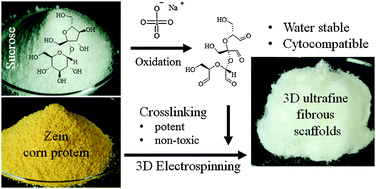Potent and regularizable crosslinking of ultrafine fibrous protein scaffolds for tissue engineering using a cytocompatible disaccharide derivative
Abstract
Sucrose, a naturally-occurring disaccharide, could be oxidized to polar polyaldehydes to improve the performance properties of tissue engineering scaffolds composed of three-dimensionally arranged ultrafine protein fibers in a controllable manner. With significantly better water stability, an in vitro study demonstrated that the biocompatibility of the oxidized sucrose crosslinked scaffolds was similar to the citric acid crosslinked ones. Due to their structural similarity to the major component in native extracellular matrices (ECMs), proteins had advantages over other macromolecules for development of tissue engineering scaffolds. We have successfully developed three-dimensional (3D) ultrafine fibrous structures from proteins that could mimic the authentic 3D architectures of native ECMs. However, the enlarged contacting area exposed to water worsened the poor water stability of proteins, and thus necessitated potent and non-toxic crosslinking. Citric acid, a biobased crosslinker, was widely recognized as safe and showed good crosslinking efficiency among non-toxic crosslinkers for proteins, though was still less potent than aldehydes. In this research, sucrose was oxidized to non-volatile polyaldehydes with high polarity and low toxicity. Compared to those crosslinked with citric acid, the 3D ultrafine fibrous zein scaffolds crosslinked with oxidized sucrose showed significantly better water stability and similar cytocompatibility via an in vitro study with preosteoblasts. In summary, oxidized sucrose could be a safe and potent crosslinker to improve water stability of macromolecule-based materials for medical and industrial applications.


 Please wait while we load your content...
Please wait while we load your content...